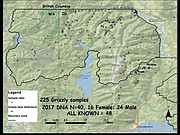Cabinet-Yaak/Selkirk Mountains grizzly monitoring update
Our 2019 field season began in early May with the arrival of our field technicians for work and training. We spent almost a week on training before crews dispersed to the field. We have two bear capture teams and one hair collection team in the Cabinet-Yaak plus one trap team and two hair collection teams in the Selkirk Mountains. Crews began capture and hair collection efforts on May 18.
Capture efforts will emphasize recapture of existing collar bears. The manufacturer of our radio collars alerted us to a software glitch that is causing many of our collars to malfunction. This year’s collars have had the software updated to avoid the issue.
Selkirk Mountains Research Monitoring
We began 2019 with five grizzly bears collared in the Selkirk Mountains (three females and two males). Capture activities have resulted in the recapture and collar change on one of the females. Trail cameras at the capture site indicated she was accompanied by a two year-old offspring, but that bear was not captured. Trapping will continue near the international border to attempt recapture of the other two females.
Cabinet-Yaak Research Monitoring
We began 2019 with six collared grizzly bears in the Cabinet-Yaak (two females and four males). One of the females was observed in May with two new cubs. The other female is four years old and probably too young to reproduce. A two year-old male was captured near Rathdrum, Idaho and was relocated to the West Cabinet Mountains in August of 2018. The bear moved north of Bonners Ferry, Idaho, and eventually into the Yaak River drainage. The bear denned near the international border. In 2019, the bear emerged and traveled into British Columbia and then west to Creston, B.C. In late May the bear moved south of the border and killed several sheep east of Porthill, Idaho and three days later killed two more sheep about five miles south of the first depredation. Traps were set and the bear was captured. Idaho Fish and Game and US Fish and Wildlife Service made a joint decision to euthanize the bear. Wildlife Services personnel assisted in the capture.
Cabinet Mountains Augmentation
A two year-old male augmentation bear was released in the West Cabinet Mountains near Spar Lake on July 21, 2018. The bear moved south from the release and crossed the Clark Fork River. The animal spent much of the summer in this area before moving north back into the West Cabinet Mountains to den for the 2018-19 winter. The animal emerged in late March and crossed the Clark Fork river moving south in late April. His most recent location was 40 miles southeast of Kellogg, Idaho, just north of the Mallard-Larkins Pioneer Area. We do expect to move another bear to the Cabinet Mountains this year as part of the continued augmentation effort.
Genetic Sampling for Research
Our genetic samples from 2017 were analyzed by the lab and returned to us. Complete results and analysis will occur in the 2018 annual report, but some of the notable results include: identification of several new offspring of augment bears in the Cabinet Mountains, evidence that a male augmentation bear has reproduced, and total numbers of bears identified by 2017 sampling in each recovery area.
Seven new augmentation offspring were identified in the Cabinet Mountains from the 2017 samples. Genetic results also indicated that male grizzly bear 723 had reproduced. Bear 723 was released in the Cabinet Mountains in 2011 as a two year-old. This is the first instance of new male genes in the population because of the augmentation effort.
Hair snagging at corrals and rub trees occurred in both recovery areas during 2017 and those results provided a minimum number of bears present during that year. In the Cabinet-Yaak, we identified
Forty-four different bears from 455 hair samples collected through the hair snagging effort. Several radio collared bears and young bears known to be present on the study area were not detected by this effort. Adding those individuals resulted in 54 bears known to be present in the area during 2017. In the Selkirk Mountains we identified 40 different bears from 225 hair samples obtained through the hair snagging effort. Again, several radio collared bears and young bears known to be present on the study area were not detected by this effort. Adding those individuals resulted in 48 bears known to be present in the US portion of the Selkirk Mountains during 2017. Several of these bears have home ranges that overlap the international boundary.
Cabinet-Yaak and Selkirk Mountains Human Caused Mortality
There are no known instances of human caused mortality thus far in the U.S. portion of the Selkirk Mountains and one instance of a mortality in the Cabinet-Yaak. This individual was the euthanized bear that killed sheep as described earlier in this report.
Acknowledgements
Capture efforts and hair snagging are part of a research and monitoring effort including cooperators and funders from Birchdale Ecological (M. Proctor), British Columbia Conservation Officer Service, Colville National Forest, Idaho Department of Lands, Idaho Fish and Game, Idaho Panhandle National Forest, Kalispel Tribe, Kootenai Tribe of Idaho, Lolo National Forest, Montana Fish, Wildlife, and Parks, Kootenai National Forest, and Washington Department of Fish and Wildlife. The effort is led by U.S. Fish and Wildlife Service through the Grizzly Bear Recovery Office but also supported by funding from the Idaho and Washington state offices of the U.S. Fish and Wildlife Service. We thank numerous private owners of timberlands that have granted access to their property for this research effort including Caribou Mountain Lodge, Hancock Forest Management, Molpus Woodlands, Stimson Lumber, and Weyerhaeuser Timber.





